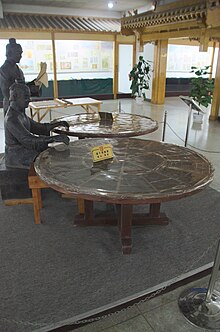|
Bi Sheng
 Bi Sheng (972–1051) was a Chinese artisan and engineer during the Song dynasty (960–1279), who invented the world's first movable type. Bi's system used fired clay tiles, one for each Chinese character, and was invented between 1039 and 1048. Printing was one of the Four Great Inventions. Because Bi was a commoner, not an educated person, little is known about his life besides this invention.[1] Movable type printingBi Sheng's invention was only recorded in the Dream Pool Essays by Chinese scholar-official and polymath Shen Kuo (1031–1095). The book provides a detailed description of the technical details of Bi Sheng's invention of movable type printing:
During the next several centuries, movable type was seldom mentioned or described. Wooden movable-type printing became widespread in the Qing dynasty (1644–1912), but did not replace block printing, probably because of the expense of creating a font of so many pieces or the low cost of a copyist.[1] The government official Wang Zhen (fl. 1290–1333) improved Bi Sheng's clay types by innovation through the wood, as his process increased the speed of typesetting as well.[3] By 1490, bronze movable type was developed by the wealthy printer Hua Sui (1439–1513). LegacyBisheng Subdistrict (畢昇社區) in Wenquan, Huanggang, Hubei is named for Bi Sheng. The Bi Sheng crater located in the LAC-7 quadrant near the northern pole on the far side of the Moon was named after Bi Sheng by the IAU in August 2010.[4] He also appears in a commemorative stamp by the Liberian post office due to his invention of movable printing. See alsoReferences
Sources
Further reading
|
||||||||||||||||||||||||||
Portal di Ensiklopedia Dunia